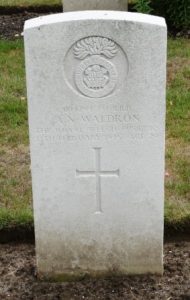Montgomery is an ancient town in the county of Montgomeryshire, to which it gives its name. The town centre lies about one mile west of the English border. The town was established around a Norman stone castle, which is situated on a prominent crag on the western edge of the Vale of Montgomery, and was built in the early 13th century to control an important ford over the River Severn, replacing the earlier motte and bailey fortification at Hen Domen. The area was given by William the Conqueror to one of his most important supporters, Roger de Montgomerie, who gave the town its name. The castle was slighted by Parliamentary forces during the Civil War. As the county town, in 1923 the Montgomeryshire County War Memorial was erected on a hill just south-west of the town to commemorate fallen servicemen from Montgomeryshire. The men of the town itself who fell during both World Wars, are commemorated on a modern war memorial, which was erected inside the towns Garden of Remembrance and unveiled on 5 September 2014, after a lot of work, and fund raising, by members of the local community.
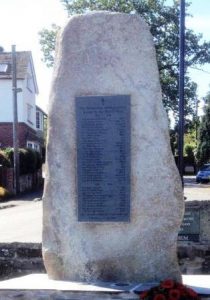
The Great War, 1914-1918
Francis William Bayson, Private, 56959, Welsh Regiment. Francis was the son of Francis and Sarah Bayson, of Well House, Montgomery. He worked as a labourer prior to enlisting with his friend, Frank Francis, into the 3/1st Battalion, Montgomeryshire Yeomanry at Welshpool on 5 November 1915. Francis was posted to Park Hall Camp, Oswestry for training, and on 8 August 1916 embarked for France, joining the 5th Infantry Base Depot at Rouen. On 1 September 1916, Francis was transferred to the 4th Battalion, Welsh Regiment, before being posted to the 10th Battalion, Welsh Regiment, which was at Ypres, attached to 114 Brigade, 38th (Welsh) Division. The battalion had made its famous assault on Mametz Wood in July 1916 before being relieved. It then took over a section of the front at Hébuterne before moving to the Ypres Salient, and taking over the Canal Bank sector at Boesinghe. The infantry battalions of the Division then began carrying out the normal pattern of rotation in the trenches, four days in the front, four in support and four in reserve, whilst also working on trench improvement, digging new trenches, and also carrying out regular patrols and trench raids. Francis suffered gas poisoning whilst in the line on 20 July, but returned to duty within days, and then was gassed again on 29 July, not returning to duty until 8 August. In the meantime, on 31 July 1917 the Division had launched its famous assault on the Pilckem Ridge, capturing Iron Cross and reaching its objective of the Steenbeek, then played a supporting role in the Battle of Langemarck, behind the 20th (Light) Division. Francis was by now back in action, when on 19 August 1917 the 10th Welsh took over the right section of the front line facing Langemarck. Francis was killed in action here on the following day, 20 August 1917. The 20-year-old is buried in Cement House Cemetery, Belgium.
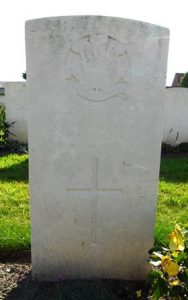
Edmund Maurice Buckley, Second Lieutenant, Royal Welsh Fusiliers. Edmund was born on 1 December 1886, the only son of Sir Edmund Buckley, Second Baronet Mawddy, and Lady Harriet Olivia Louise Buckley (nee Lloyd), of Aberhirnant Hall, Bala; Plas Dinas, Dinas Mawddy; Milford Hall, Newtown; Grotton Hall, Saddleworth; and of Maesllan, Barmouth. He was educated at Cheltenham College before entering Manchester University in 1904 to study engineering. Upon graduating, he begun working for Humber Works Limited at Beeston, and Coventry and was placed in charge of the Motor Cycle Repair Department. He played rugby for Coventry and was the captain of the second XV. Edmund enlisted into the Public Schools Battalion, London Regiment as a Private at the outbreak of war, and on 21 September 1914 was commissioned into the 7th Battalion, Royal Welsh Fusiliers. The battalion was a Territorial unit, which mobilised for war at Newtown in August 1914, as part of North Wales Brigade, Welsh Division and moved to Conway until the end of the month, before moving to Northampton. In December the Division moved to Cambridge and then in May 1915 to Bedford, where the Division was numbered and the formation became 158 Brigade, 53rd (Welsh) Division. On 19 July 1915 the entire Division sailed from Devonport for Imbros and on 9 August 1915 landed at Suvla Bay. The infantry moved off the beaches into the bush, but due to a lack of maps and no knowledge of the terrain, many of the units became disorientated, and the situation became chaotic. On the morning of 10 August, the Division took part in an advance on Scimitar Hill under heavy fire and suffered terrible casualties, before being forced to withdraw. Edmund was wounded during the fighting, and died of his wounds on 12 August 1915, aged 29. He is buried in Lancashire Landing Cemetery, Gallipoli. Upon the death of his father in 1919, the title of Baronet Mawddy also died. Edmund is also commemorated on at least three other war memorials, at Newtown, Barmouth and at Dinas Mawddy.
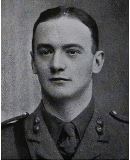
Hugh Thompson Davies, Corporal, 10482, Royal Welsh Fusiliers. Hugh was born at Montgomery in 1890, the son of Charles Davies and Annie Davies (nee Fletcher), of Princes’ Street. He was baptised at Montgomery on 5 April 1891. His mother was the daughter of Hugh Fletcher of Montgomery, whilst his father was a Draper. By 1901 the family had moved to 4, Cross Street, Newtown, but sadly later that year Charles died. Hugh worked as a Mason prior to enlisting into the Royal Welsh Fusiliers at Dolgellau on 26 August 1910. He was posted to the Depot at Wrexham, before being posted to the 1st Battalion, Royal Welsh Fusiliers on 13 December 1910. He served with the battalion for 11 months, before being transferred to the 2nd Battalion, Royal Welsh Fusiliers, which was in India, on garrison duties. On 3 March 1914 Hugh re-joined the 1st Battalion, Royal Welsh Fusiliers, which was on garrison duties in Malta. The battalion sailed for England on 3 September 1914, and joined 22 Brigade, 7th Division at Lyndhurst, before the entire Division embarked for the front, landing at Zeebrugge on 7 October 1914. By the time the Division landed, the City was in the process of falling to the Germans, so the 7th Division made the long march to Ypres, becoming the first British Division to hold the city. The remainder of the BEF joined the battalion soon afterwards, and a defensive line was created to the east of the city. The Division fought during the First Battle of Ypres, and helped stop the German advance through Belgium, and in March 1915 fought at the Battle of Neuve Chapelle. The Division remained in the area after the battle, then on 8 May 1915 took part in the Battle of Aubers Ridge. A week later, on 16 May 1915 the Allies made another attack, the Battle of Festubert, in the same sector. The 1st RWF had moved from billets at Essars on the previous day, marching via Bethune to its starting positions at Rue Cailloux, and at dawn on 16 May 1915 launched its assault on the German lines opposite. The battalion swept through the German front and 2nd lines, before becoming held up, suffering very heavy casualties. Hugh was killed in action at sometime during the assault that day. The 24-year-old has no known grave and is commemorated on the Le Touret Memorial, Richebourg-L’avoue, France. Hugh is not commemorated on the Montgomery war memorial.
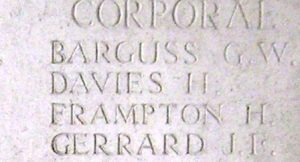
Frank Edward James Francis, Private, 56978, Welsh Regiment. Frank was the son of Francis and Elizabeth Francis, of Clive Terrace Montgomery. He enlisted into the 3/1st Battalion, Montgomeryshire Yeomanry, together with his friend, Francis Bayson, at Welshpool on 15 November 1915, and was posted to Park Hall Camp, Oswestry for training. On 8 August 1916 Frank embarked for France, joining the 5th Infantry Base Depot at Rouen. On 1 September 1916, Francis was transferred to the 4th Battalion, Welsh Regiment, before being posted to the 10th Battalion, Welsh Regiment, which was at Ypres, attached to 114 Brigade, 38th (Welsh) Division. The battalion had made its famous assault on Mametz Wood in July 1916 before being relieved. It then took over a section of the front at Hébuterne before moving to the Ypres Salient, and taking over the Canal Bank sector at Boesinghe. The infantry battalions of the Division then began carrying out the normal pattern of rotation in the trenches, four days in the front, four in support and four in reserve, whilst also working on trench improvement, digging new trenches, and also carrying out regular patrols and trench raids. Frank was taken ill with pleurisy on 2 October, and evacuated via the 46th Casualty Clearing Station before retuning to England for treatment. He re-joined the 10th Welsh at Boesinghe on 27 March 1917. On 31 July 1917 the Division had launched its famous assault on the Pilckem Ridge, capturing Iron Cross and reaching its objective of the Steenbeek. Frank was killed in action four days into the battle, whilst in the line facing Langemarck, on4 August 1917. The 21-year-old has no known grave and is commemorated on the Ypres (Menin Gate) Memorial, Belgium. His brother, Frederick, was killed in France in 1918.

Frederick William Francis, Private, 57490, Manchester Regiment. Frederick was the son of Francis and Elizabeth Francis, of Clive Terrace Montgomery. He enlisted into the army at Wrexham, and would have been posted to a battalion of the Training Reserve, probably at Kinmel Park. Frederick was drafted out to France in the summer of 1918, and was posted to the 2nd Battalion, Manchester Regiment, which was attached to 96 Brigade, 32nd Division. At the end of July 1918, the Division had enjoyed a brief rest spell in the Proven area, before entraining on 7 August and moved south, detraining at Hargest. Before marching to billets at Brique Mesnil, west of Amiens. Over the coming days the Division marched forwards into the battle area, towards the locality of Villers-Bretonneux, where a great victory had been won by the Allies on 8 August, and on 10 August the 32nd Division joined the fight, moving into action at Parvillers and Damery Woods. Over the coming days the Division took part in the advance here along the main road from Amiens towards St. Quentin, reaching Harbonnières by 18 August. To the north of the Division the Allies launched a general offensive on 21 August, and began driving towards the mighty Hindenburg Line, along a wide front. By the end of the month the 32nd Division had reached and captured Ablaincourt, to the south of Péronne, before capturing the village of Misery and forcing the Somme crossings to the east by 6 September. By 12 September the Division had reached St. Quentin, then two days later the 2nd Manchester’s went to Corbie for a rest. By 25 September the battalion had moved to Tertry, before the Allies launched a full-scale assault on the St Quentin Canal from 29 September, and the 2nd Manchester’s crossed the line at Vendelles that afternoon, before advancing to Magny-La-Fosse, east of Bellenglise. With the Hindenburg Line broken, the Allies continued to advance. Frederick was killed during a relatively quiet day advancing near Berny on 2 October 1918. The 19-year-old is buried in Joncourt British Cemetery, France. His headstone commemorates two men, as he was buried with a comrade, and Frederick’s name is at the bottom.
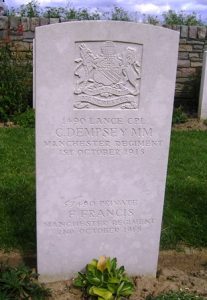
Thomas Francis, Private, 18035, King’s Shropshire Light Infantry. Thomas was born at Court Bytake, Montgomery in 1894, the son of Thomas Francis and Susannah Francis (nee Williams), and was baptised at Montgomery on 12 July 1894. His father was an agricultural worker and shepherd, and over the coming years the family moved several times, including to Upper Barn Cottage, New House, Shipton, Much Wenlock; The Outtrack, Craven Arms; and later to The Tally Ho, Boulden, Diddlebury, Craven Arms. Thomas enlisted at Shrewsbury together with his elder brother William into the King’s Shropshire Light Infantry, and after training at Pembroke Dock, the brothers embarked for France on 27 October 1915, before being posted to the 7th Battalion, King’s Shropshire Light Infantry. The battalion had only been in France a month, initially attached to 76 Brigade, 25th Division, but by the time the brothers joined its ranks, was at Ypres attached to 8 Brigade, 3rd Division, the Division having been relieved from the Sanctuary Wood sector a week earlier, moving to a rest camp in the Steenvoorde area. On 23 November the Division moved back into the line, taking over the section running between St. Eloi and Hill 60, and the 7th KSLI marched to Reninghelst that day, in Divisional reserve. The new sector was situated just south of the Ypres-Commines canal in the southern neck of the salient, the line facing roughly south-east. Headquarters of the 7th KSLI was situated in Spoil Bank and the feature known as The Bluff was on the opposite bank of the canal. The battalion remained here over the coming months, rotating in the front line with the 1st Northumberland Fusiliers until early February 1916, when the Division moved to Eperlecques for a rest. Less than two weeks later, on 14 February, the Germans launched an offensive against the Ypres Salient, capturing The Bluff, so the 3rd Division was ordered back into the line to recapture the lost ground. On 2 March 1916, 8 Brigade supported an assault by 76 Brigade against The Bluff, an action which saw the 10th RWF, in the latter Brigade, decimated. The 7th KSLI took over the new front line, which it consolidated, before being relieved on the night of 7-8 March, and moved back to Reninghelst. On 11 March the battalion moved back into its old sector on the Spoil Bank south of the canal, and on 19 March took up reserve positions for an assault by 9 Brigade on the Mound at St. Eloi, remaining in the sector over the coming weeks. Thomas was killed at St. Eloi on 3 April 1916, just hours before the 7th KSLI was relieved. The 23-year-old has no known grave and is commemorated on the Ypres (Menin Gate) Memorial, Belgium. His brother, William, had been wounded at St. Eloi and had died of his wounds the previous day. Neither Thomas, nor his brother William, are commemorated on the Montgomery war memorial.

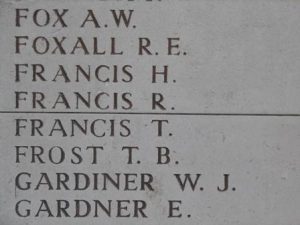
William Orlando Francis, Private, 18036, King’s Shropshire Light Infantry. William was born at Buck Yard, Montgomery in 1890, the son of Thomas Francis and Susannah Francis (nee Williams), and was baptised at Montgomery on 7 December 1890. His father was an agricultural worker and shepherd, and over the coming years the family moved several times, including to Upper Barn Cottage, New House, Shipton, Much Wenlock; The Outtrack, Craven Arms; and later to The Tally Ho, Boulden, Diddlebury, Craven Arms. William enlisted at Shrewsbury together with his younger brother Thomas into the King’s Shropshire Light Infantry, and after training at Pembroke Dock, the brothers embarked for France on 27 October 1915, before being posted to the 7th Battalion, King’s Shropshire Light Infantry. The battalion had only been in France a month, initially attached to 76 Brigade, 25th Division, but by the time the brothers joined its ranks, was at Ypres attached to 8 Brigade, 3rd Division, the Division having been relieved from the Sanctuary Wood sector a week earlier, moving to a rest camp in the Steenvoorde area. On 23 November the Division moved back into the line, taking over the section running between St. Eloi and Hill 60, and the 7th KSLI marched to Reninghelst that day, in Divisional reserve. The new sector was situated just south of the Ypres-Commines canal in the southern neck of the salient, the line facing roughly south-east. Headquarters of the 7th KSLI was situated in Spoil Bank and the feature known as The Bluff was on the opposite bank of the canal. The battalion remained here over the coming months, rotating in the front line with the 1st Northumberland Fusiliers until early February 1916, when the Division moved to Eperlecques for a rest. Less than two weeks later, on 14 February, the Germans launched an offensive against the Ypres Salient, capturing The Bluff, so the 3rd Division was ordered back into the line to recapture the lost ground. On 2 March 1916, 8 Brigade supported an assault by 76 Brigade against The Bluff, an action which saw the 10th RWF, in the latter Brigade, decimated. The 7th KSLI took over the new front line, which it consolidated, before being relieved on the night of 7-8 March, and moved back to Reninghelst. On 11 March the battalion moved back into its old sector on the Spoil Bank south of the canal, and on 19 March took up reserve positions for an assault by 9 Brigade on the Mound at St. Eloi, remaining in the sector over the coming weeks. William was badly wounded at St. Eloi, and died of his wounds at Remy Sidings Casualty Clearing Station on 2 April 1916. The 25-year-old is buried in Lijssenthoek Military Cemetery, Belgium. His brother, Thomas, was killed at St. Eloi the following day. Neither William nor his brother Thomas are commemorated on the Montgomery war memorial.

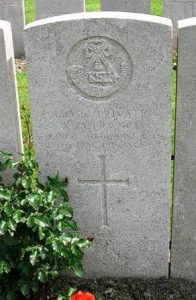
Frederick Gould, Private, 290247, Royal Welsh Fusiliers. Frederick was born at Liverpool in 1895, the son of George and Emma Gould. By 1911 the family had moved to Arthur Street, Montgomery, and young Frederick was working as a cowman on Bacheldre Farm in Churchstoke. Frederick enlisted into the 7th Battalion, Royal Welsh Fusiliers at Newtown, and was posted to the 3/7th Battalion at Park Hall, Oswestry for training. He was later drafted to Egypt, joining ‘A’ Company of the 1/7th Battalion, Royal Welsh Fusiliers, which was attached to 158 Brigade, 53rd (Welsh) Division. The Division had been evacuated from Gallipoli in December 1915, moving to Egypt to join the EEF, and helped guard the Suez Canal before taking part in operations to drive the Turks out of the Sinai. The EEF then turned its attention onto driving the Turks out of Palestine, and on 26 March 1917 launched its first offensive against the coastal city of Gaza, which guarded the road to Jerusalem. Initial gains during the day were lost when the assaulting divisions lost touch with each other and communication broke down when a thick fog cloaked the battlefield. A second attempt to force Gaza was launched on 17 April, which also failed, and the EEF suffered a change in leadership, with Sir Edmund Allenby assuming command, before being re-organised, and a third offensive was launched against a wider front from Beersheba to Gaza on 31 October 1917. This time the Turkish defences were breached, and the road to Jerusalem now lay open and the EEF began to advance north. On 6 November 1917, 158 Brigade launched an attack on the Khuweilfeh Heights, and once secured, the EEF continued its advance into the Judean Hills, the 53rd Division capturing Hebron and Bethlehem, before securing the Jerusalem to Jericho Road. Allenby finally made his triumphant entry into Jerusalem on 11 December. The men of the Division had Christmas dinner in torrential rain in the Valley of Jehoshaphat, and on the following day the Division lined up alongside the 10th, 60th and 74th Divisions, in readiness to continue the advance. At 23.30 on 26 December the Turks launched a massive counter-attack, intending to recapture Jerusalem, and fighting raged all through the night and following day. The bulk of the fighting involving the 53rd Division was carried by 160 Brigade, so at dawn on 28 December, 158 Brigade moved forwards and took over the fight, before the EEF was ordered to advance again, and the 7th RWF assaulted the village of Suffa. Frederick was killed when the battalion attacked the village under heavy machine-gun fire that day, 27 December 1917. The 22-year-old is buried in Jerusalem War Cemetery, Israel.
Charles Henry Grant, Private, 13056, Sherwood Foresters (Notts and Derby Regiment). Charles was born in Johannesburg in 1897, the son of John Henry Grant and Rose Annie Grant (nee Davies). His father died on 5 January 1901, so Rose moved back to Britain, taking her three sons, Henry, Charles and Edwin, to live with her parents at 1, Cross Houses, Montgomery. Charles was later adopted after the death of his grandparents and was living in Retford, Nottinghamshire when war erupted, where he enlisted into the 9th Battalion, Sherwood Foresters. The battalion had formed at Derby, moving to Grantham to join 33 Brigade, 11th (Northern) Division, and in July 1915 embarked at Liverpool for Mudros, landing at Cape Helles, Gallipoli on 20 July, and remained there until transferring to Suvla Bay, landing on 7 August 1915. The Division then took part in the heavy fighting which followed the landing over the coming days, seeing heavy casualties for no real gain, before the campaign stagnated again. Winter hot the Gallipoli Peninsula hard that year, and the troops, already in squalid conditions, suffered weeks of torrential rain, followed by flooding so bad that the dead were washed out of their shallow graves and carried in the torrents down the trenches in places. Then the snow came, bringing with it yet more misery, and evacuation then became considered. Charles was killed in action less than a month before the eventual evacuation, on 27 November 1915. The 18-year-old has no known grave and is commemorated on the Helles Memorial, Gallipoli.
Albert Edward Jones, Private, 290728, Royal Welsh Fusiliers. Albert was the son of Robert and Agnes Jones, of 58, Ladywell Street, Newtown. He worked as a farm labourer at Montgomery prior to returning to Newtown to enlist into the 7th Battalion, Royal Welsh Fusiliers on 12 October 1914. Albert was posted to the 3/7th RWF at Park Hall, Oswestry for training, and on 31 May 1916 embarked at Devonport aboard the HT Kalyan, disembarking at Alexandria on 11 June 1916, before joining the 1/7th Battalion, Royal Welsh Fusiliers, which was attached to 158 Brigade, 53rd (Welsh) Division. The Division had been evacuated from Gallipoli in December 1915, moving to Egypt to join the EEF, and helped guard the Suez Canal before taking part in operations to drive the Turks out of the Sinai. The EEF then turned its attention onto driving the Turks out of Palestine, and on 26 March 1917 launched its first offensive against the coastal city of Gaza, which guarded the road to Jerusalem. Initial gains during the day were lost when the assaulting divisions lost touch with each other and communication broke down when a thick fog cloaked the battlefield. Albert was posted as missing during the battle that day, and was afterwards adjudged to have been killed in action on that date. The 19-year-old has no known grave and is commemorated on the Jerusalem Memorial, Israel.
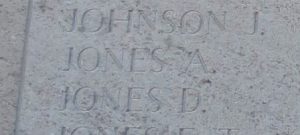
James Morris Jones, Private, 22135, The King’s (Liverpool Regiment). James was born at Guilsfield in 1888, the son of Reverend Owen Baldwyn Jones and Elizabeth Jones. His parents later resided at the Post Office, Montgomery. James worked as a Grocer’s Assistant prior to enlisting into the 4th Battalion, The King’s (Liverpool Regiment) at Liverpool on 5 November 1914. James was then posted to the 17th Battalion, The King’s (Liverpool Regiment). The battalion was raised in Liverpool by Lord Derby, before moving to the old watch factory at Prescot, and on 30 April 1915 moved to Belton Park, Grantham to join 89 Brigade, 30th Division. On 7 November 1915 James landed with the battalion at Boulogne, and the entire Division moved to the Somme sector. The Division spent the coming months gaining experience in trench warfare, before taking part in the Somme offensive, which was launched on 1 July 1916, capturing the village of Montauban. The Division then fought during the latter stages of the offensive, during the Battle of Le Transloy, before wintering on the Somme. James came home for two weeks leave in December 1916, but was back in France after the New Year. In March 1917 the Division followed the German Retreat to the Hindenburg Line, and in April took part in the First Battle of the Scarpe, and then at the later Second Battle of the Scarpe. Later that year the Division was moved north to Ypres, and fought at the Battle of Pilckem Ridge. By the beginning of 1918 the Division was stationed near St. Quentin, and when the Germans launched their Offensive here on 21 March, the Division took part in the terrible fighting which followed, retreating back over the Somme Crossings. On 30 March the battered Division was pulled from the line to rest and rebuild, entraining for St. Valery-sur-Somme, before moving to Flanders, reaching Elverdinghe by 5 April, and took over the Poelcapelle Sector, north-east of Ypres. The Germans launched the second phase of their offensive just to the south, in the Lys Sector, on 9 April, and broke through the Portuguese Lines, so the 30th Division was rushed south, near St. Jans Cappel, by 18 April, to take part in the desperate fighting. The Division then spent a week in the Voormezeele Sector, before moving to the Vierstraat Sector by 6 May, where the coming days were spent under almost constant artillery fire, mixed with gas shells. James was badly wounded by shrapnel here on 7 May, and was evacuated via the 99th Field Ambulance to the 10th Casualty Clearing Station at Arneke, where he died of his wounds on the following day, 8 May 1918. The 34-year-old is buried in Arneke British Cemetery, France. His brother, Thomas, had been killed in France in 1916.
Richard Francis Jones, Private, 3560, Welsh Guards. Richard was the son of Isaac and Mary Jones, of Montgomery. By 1911 Richard was living at 35, Broadway, Shifnal, Shropshire, where he worked as a Grocers Vanman. Richard was living at Froncysyllte, Wrexham when war broke out, and he enlisted at Wrexham into the Welsh Guards. He was posted to the 2nd Battalion, Welsh Guards at Tadworth for training, and probably embarked for France late in 1916 among a number of drafts sent to reinforce the 1st Battalion, Welsh Guards following heavy losses during the Somme offensive. The battalion was attached to the 3rd Guards Brigade, Guards Division. The Division remained on the Somme over the winter, and followed the German withdrawal to the Hindenburg Line in March 1917 before being withdrawn from the line to rest and rebuild. Later that year the Division moved north to Ypres, taking up positions left of the 38th (Welsh) Division, and took part in the Battle of Pilckem Ridge on 31 July. The Guards Division fought at Ypres until 12 October when it was transferred south, to take part in the Battle of Cambrai. The Welsh Guards went into action at Cambrai on 22 November, but the situation there had already broken down, as the Germans had counter-attacked, and the British were under intense pressure. The Welsh Guards then had a short spell in reserve to rest, but a second German counter-attack on 30 November broke the British lines, and the Welshmen were ordered forwards to help hold the line. Richard was killed in action when the Welsh Guards launched their own counter-attack on 1 December 1917. The 32-year-old has no known grave and is commemorated on the Cambrai Memorial, Louverval, France. Richard is also commemorated at Froncysyllte.
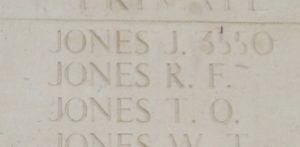
Thomas Harri Jones, Private, 17392, The King’s (Liverpool Regiment). Thomas was born at Guilsfield in 1887, the son of Reverend Owen Baldwyn Jones and Elizabeth Jones. His parents later resided at the Post Office, Montgomery. Thomas worked as a Grocer prior to enlisting at Liverpool into the 19th Battalion, The King’s Shropshire Light Infantry on 31 August 1914. The battalion was raised in Liverpool by Lord Derby, before moving to the old watch factory at Prescot, and on 30 April 1915 moved to Belton Park, Grantham to join 89 Brigade, 30th Division. On 7 November 1915 Thomas landed with the battalion at Boulogne, and the entire Division moved to the Somme sector. The Division spent the coming months gaining experience in trench warfare, before taking over the Carnoy Sector. The infantry battalions of the Division then began the usual routines of trench rotation, usually four days in the front line, four in support and four in reserve, broken up by supplying working parties, training and carrying out trench raids. On 29 June 1916 the 19th King’s moved to Bray from a rest camp behind the lines, and on the following night moved into their battle positions, ready to take part in the opening assault of the Somme offensive. At 07.20 on the following morning, 1 July 1916, a series of massive underground mines were blown before the infantry attacked on the Somme front. On that first day, the 30th Division attacked and captured the village of Montauban, whilst the 19th King’s remained in support, carrying supplies forwards to the assaulting troops. This work continued over the coming days, before the battalion was relieved on 5 July, and moved to a tented camp at Bois Des Tailles. Thomas had been badly wounded on 1 July and was initially posted as missing, however he was recovered from the battlefield, and was evacuated to the 45th Casualty Clearing Station at Daours, where his leg was amputated. Sadly, he died of his wounds on 5 July 1916. The 29-year-old was buried in Daours Communal Cemetery Extension, France. His brother, James, was killed in France in 1918.
William Lloyd Jones, Private, 2478, Monmouthshire Regiment. William was born at Chirbury in 1894, the illegitimate son of Rebecca Jones. By 1901 Rebecca and William were living with her mother, Jane Jones, at 2, Well Houses, Montgomery. William was working in the Rhondda Valley prior to the war, and enlisted at Merthyr Tydfil into the 3rd Battalion, Monmouthshire Regiment. The battalion was a Territorial Army unit, originally attached to the 53rd (Welsh) Division, and upon mobilisation moved to Pembroke Dock. It then left the Division, together with the 1st and 3rd Monmouth’s, and landed in France on 14 February 1915, joining 83 Brigade, 28th Division, at Ypres, where the Division held the line near Wulverghem. The infantry battalions of the Division then began to rotate in the trenches, taking turns in the front line, in support, then in reserve, whilst the newly arrived 3rd and 1st Monmouth’s spent their first month in the line being attached to other units for trench familiarisation. On 8 April the 28th Division relieved the French troops holding the section of the line east of Ypres, east of Polygon Wood, and on 17 April the 3rd Monmouth’s took over the front line, to begin what ended up as a 17-day tour in the trenches. Five days into this epic spell, on 22 April 1915 the Germans launched the first ever poison gas attack just to the north, at Gravenstafel, and overwhelmed the French Colonial troops holding that sector, opening up a huge gap in the line. The Germans followed this up with an infantry assault, the opening attack of the Second Battle of Ypres, and the Allies had to throw the Canadians into action to attempt to plug the gap. Fighting raged in this sector over the coming days, forcing the 28th Division, and the 3rd Monmouth’s, to withdraw to positions at Potijze, where they came under attack on 8 May, suffering heavy casualties from artillery fire. Later that day the 3rd Monmouth’s were relieved, moving to Vlamertinghe to rest briefly, before the survivors were formed into a Composite Battalion with the other units from 83 Brigade, and moved back into the front line at Potijze, due to the severity of the situation. William was killed in action soon afterwards, during heavy fighting at Potijze on 19 May 1915. The 21-year-old has no known grave and is commemorated on the Ypres (Menin Gate) Memorial, Belgium. There is one William Lloyd Jones commemorated on the Montgomery war memorial, yet two men of that name with ties to the town.
William Lloyd Jones, Private, 37553, Lancashire Fusiliers. William was born in Newtown in 1896, the eldest son of John Walter Jones and Ann Penelope Jones (nee Evans). By 1901, the family was living in Salford, where Walter had found work in the cotton mills and William later found work as a Stores Boy, for an electrical engineering business. William’s mother, Ann, was the daughter of Thomas Henry Evans and Jane Evans, of Arthur Street, Montgomery. William enlisted at Salford into the 1/7th Battalion, Lancashire Fusiliers, and after completing his training was posted to France in the late summer of 1916, joining the 2nd Battalion, Lancashire Fusiliers. The battalion was on the Somme by then, attached to 12 Brigade, 4th Division. The Division had moved to the Somme from the Ypres Salient in October 1916, taking over trenches near Trônes Wood, and fought at the Battle of Le Transloy, launching an assault on 12 October which resulted in terrible casualties, over 300 in the 2nd Lancashire Fusiliers alone. William was most likely among 176 men who joined the battalion on 18 October, after that attack. The battalion then moved into support at John Bull Trench and Cow Trench, before moving into the front line on 23 October, taking part in another assault, to take Dewdrop Trench, which ran between Lesboeufs and Le Transloy, suffering another 150 casualties. The Somme offensive then died down, and the 4th Division wintered in the Somme trenches, in terrible conditions. At the end of March 1917, the Division began to move north to the Arras Sector, moving to billets around Étrun, west of Arras, before moving into front-line positions near Athies. On 9 April the Division launched an assault on the Germans, as part of the opening of the Battle of Arras, capturing a large number of prisoners and taking the German 4th trench system, and reached the line of the Fampoux to Gavrelle Road, digging in eat of the road due to heavy machine-gun fire. The 2nd South Lancs were relieved on 12 April and moved into reserve to rest and refit, moving back into the line east of Fampoux at the end of the month. On 3 May the battalion took part in another attack, behind a creeping artillery barrage, towards Roeux Chemical Works, but were beaten back. William was posted as missing, believed killed in action on 23 May 1917. The battalion was in reserve, resting at the time, so he was probably killed during one of the actions preceding the battalion’s relief. The 20-year-old has no known grave and is commemorated on the Arras Memorial, France. There is one William Lloyd Jones commemorated on the Montgomery war memorial, yet two men of that name with ties to the town.
Oscar William Lin, First Mate, Mercantile Marine. Oscar was born at Rusholme, Lancashire on 1 April 1879, the son of Thomas Henry Lin and Caroline Lin (nee Embrey). By 1891 the family was residing at Montgomery, with Caroline’s father, Charles Embrey, and ran The Plough Inn, at Montgomery, but a year later, Oscar’s father, a former Merchant Mariner, died. Oscar then joined the Mercantile Marine himself as a young man, and by the time of the 1901 Census was aboard ship at Swansea. By the time war erupted, Oscar was serving as First Mate aboard the defensively armed steamer, SS Kennington. Oscar was home on leave early in 1918 when he married Ethel Dockwray, at South Shields. He then returned to sea after their brief honeymoon, and re-joined Kennington. Sadly, just five months before the Armistice on 12 June 1918, Kennington was some fifteen miles off Flamborough Head when she was torpedoed and sunk by a German submarine, with the loss of four lives. Oscar was 38-years-old when he died that day, and is commemorated on the Tower Hill Memorial, London.
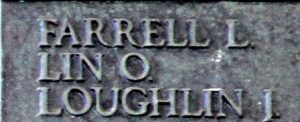
John Lloyd, Lance Corporal, 290314, Royal Welsh Fusiliers. John was born at Montgomery in 1892, the son of William and Jane Lloyd. The family later resided at Rownal Farm, Chirbury Road. John worked as a Haulier prior to enlisting into the 7th Battalion, Royal Welsh Fusiliers at Newtown on 8 September 1914. The battalion was a Territorial unit, which mobilised for war at Newtown in August 1914, as part of North Wales Brigade, Welsh Division and moved to Conway until the end of the month, before moving to Northampton. In December the Division moved to Cambridge and then in May 1915 to Bedford, where the Division was numbered and the formation became 158 Brigade, 53rd (Welsh) Division. On 19 July 1915 the entire Division sailed from Devonport for Imbros and on 9 August 1915 landed at Suvla Bay. The infantry moved off the beaches into the bush, but due to a lack of maps and no knowledge of the terrain, many of the units became disorientated, and the situation became chaotic. The Division was eventually evacuated from Gallipoli in December 1915, moving to Egypt to join the EEF, and helped guard the Suez Canal before taking part in operations to drive the Turks out of the Sinai. The EEF then turned its attention onto driving the Turks out of Palestine, and on 26 March 1917 launched its first offensive against the coastal city of Gaza, which guarded the road to Jerusalem. Initial gains during the day were lost when the assaulting divisions lost touch with each other and communication broke down when a thick fog cloaked the battlefield. A second attempt to force Gaza was launched on 17 April, which also failed, and the EEF suffered a change in leadership, with Sir Edmund Allenby assuming command, before being re-organised, and a third offensive was launched against a wider front from Beersheba to Gaza on 31 October 1917. This time the Turkish defences were breached, and the road to Jerusalem now lay open and the EEF began to advance north. On 6 November 1917, 158 Brigade launched an attack on the Khuweilfeh Heights. John was killed in action during the assault that day. The 25-year-old has no known grave and is commemorated on the Jerusalem Memorial, Israel.
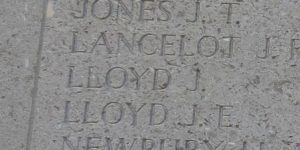
William Whittingham Longley, Driver, 92691, Royal Field Artillery. William was born at 2, Kerry Road, Montgomery in 1892, the son of William Longley and Margaret Longley (nee Whittingham), and was baptised at Montgomery on 2 April 1893. His mother was the daughter of William and Anne Whittingham, of 2, Kerry Road, and his father was from Manchester. The family had moved to Manchester by 1901, and lived at 7, Gregory Road, Openshaw. William enlisted into the Royal Field Artillery at Manchester and was posted to the 56th Battery, Royal Field Artillery, embarking for France on 29 October 1915, and joining it at Bethune, where the battery was attached to the 2nd Division. The Division had just taken part in heavy fighting at the Battle of Loos, and remained in the Loos sector over the winter of 1915-16. William took ill at some time over the winter, and was invalided back to England. William died of rheumatic fever in hospital at Corsham, Hampshire on 15 March 1916. The remains of the 23-year-old were brought home for burial in St. Barnabas Churchyard, Openshaw. There is an alternative commemoration for him on the Screen Wall at Manchester Southern Cemetery. William is not commemorated on the Montgomery war memorial.
Alfred George Ernest Morris, Rifleman, S/1673, Rifle Brigade. Alfred was the son of Charles William Morris and Anne Morris (nee Owen), of Kerry Street, Montgomery. He was living in South Wales as a young man, and worked as a Baker prior to enlisting at Abertridwr into the Rifle Brigade on 4 September 1914. Alfred was posted to the Depot at Winchester for training, initially destined for the 9th Battalion, Rifle Brigade, but was soon transferred to the 12th Battalion. Alfred had not been at Winchester long, before it became apparent that he was suffering from ill-health, and he was diagnosed as suffering from heart disease and tuberculosis, so he was discharged as medically unfit on 27 October 1914. Alfred was sent to a Sanatorium for treatment, but his health continued to fail, and Alfred returned home, where he died of tuberculosis on 30 October 1916. His service papers state that his illnesses were not helped by spending almost a month under canvas as the Depot at Winchester after enlistment. The 22-year-old was buried in St. Michael’s Churchyard, Montgomery.
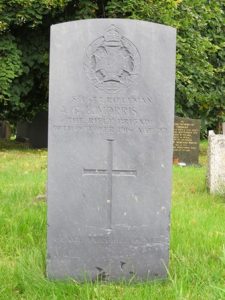
Charles William Morris, Private, 41360, Leicestershire Regiment. Charles was the son of Evan and Emma Morris, of Chirbury Road, Montgomery. He was working for George Hattersley & Sons Ltd at Keighley, in Yorkshire at some time when war erupted and enlisted at Keighley into the army. After completing his training, Charles was drafted to France in the winter of 1917/18, and was posted to the 6th Battalion, Leicestershire Regiment, which was attached to 110 Brigade, 21st Division. Charles probably joined the battalion at Épehy, where the 21st Division was holding a sector of the front facing the Hindenburg Line. During the opening weeks of 1918 it was becoming apparent that the Germans were planning something, as a lot of activity could be heard from behind the German lines. On 16 March the 6th Leicester’s launched a trench raid upon the German lines facing them in order to gain intelligence, bringing back a prisoner for interrogation. On the following day the battalion was relieved, and moved into support trenches. At dawn on 21 March the battalion received orders to Stand-To, as the entire sector, from Croisilles to La Fère, was hit by a massive German artillery bombardment. Soon afterwards the German infantry attacked, and blew holes in the Allied front line. The 21st Division was among those hit hard by the German offensive, and over the coming days saw heavy casualties as it was driven back towards Maricourt, then to Bray and finally reaching Heilly, where the Division was relieved at the end of the month. The Division then moved to the Kemmel area, to rest and refit but, unfortunately, the Germans launched the second phase of their offensive in this sector, in the Lys Valley, on 9 April, and the Division again became caught up in terrible fighting, being driven back to Zillebeke Lake and saw several weeks of defensive fighting before being transferred south, to the peaceful Aisne Sector, at the beginning of May. Again, the Division was unfortunate, as the Germans launched their third, and final, offensive of the war in the Aisne Sector on 27 May, and the Division again became caught up in desperate fighting along the Chemins-Des-Dames. During the middle of June, the Division was relieved and moved to the area around Puchevillers, in the rear sector of the Somme front, where it rebuilt again before taking over the Acheux Sector, then moved to positions west of Hamel, and to the north of the 38th (Welsh) Division, where the Division readied for the forthcoming Allied offensive. At dawn on 21 August 1918 the Allies attacked over a broad front, and the 21st Division crossed the River Ancre, before assaulting Thiepval Ridge, in conjunction with the 38th Division. The 21st Division continued to advance, capturing Battery Valley and Boom Ravine over the coming days, moving through Le Sars and by 28 August captured the Butte de Warlencourt and by the end of August reached the Bapaume to Péronne Road. The Division maintained its advance towards the Canal du Nord over the coming days, reaching Sailly-Saillisel by 8 September. Charles was wounded at some time during the advance past the Bapaume to Péronne Road, and was evacuated to the Casualty Clearing Station at Varennes, where he died of his wounds on 14 September 1918. The 19-year-old is buried in Varennes Military Cemetery, FFrance. He is also commemorated on the Riddlesden War Memorial, in Yorkshire.
Isaac Morris, Private, 104007, Canadian Infantry. Isaac was born at Montgomery on 27 March 1885, the illegitimate son of Eliza Morris. His mother married Richard Pritchard in 1886, and the couple set up home at 1, Clive Terrace, Montgomery. By 1901 Isaac was living at Merthyr Tydfil, where he worked as a coalminer, then on 31 March 1911 he sailed for Canada aboard the SS Virginian from Liverpool to St John, New Brunswick, becoming a farmer at Hazelwood, Saskatchewan. On 12 April 1916 Isaac enlisted into the 68th Battalion, Canadian Infantry at Regina, Saskatchewan. On 1 May 1916 the battalion embarked at Halifax for England, and upon disembarkation on 8 May entrained for the Canadian Camp at Bramshott to continue its training. On 29 June Isaac embarked for France, joining the Canadian Base Depot at Le Havre, before being posted to the 28th Battalion, Canadian Infantry, joining the battalion on 14 July. The battalion was at Ypres attached to the 6th Brigade, 2nd Canadian Division, but in August the Canadians moved south to the Somme, to take part in the attacks on Mouquet Farm and Courcelette. The Canadians followed the German withdrawal to the Hindenburg Line in March 1917, before taking part in the famous assault on Vimy Ridge on 9 April 1917. On 12 July 1917 Isaac was in the line at Maroc with the battalion when he slipped into a shell-hole and broke his leg, and he spent several weeks in hospital before returning to Bramshott. He did not re-join the 28th Battalion until 31 August 1918, by which time the Canadians had taken part in the great victory at Villers-Bretonneux on 8 August. On 21 August the Allies launched an assault against a wider front, and over the coming days head begun the advance towards the Hindenburg Line. The 28th Battalion was at Wailly Hut Camp when Isaac re-joined, but within a week had moved into reserve positions behind the 2nd Canadian Division at Buissy Switch, near Hendecourt. The battalion did not see much action over the coming weeks, then by 1 October the Battalion moved to the Bourlon area, preparatory for the attack on the city of Cambrai, and joined the offensive again that day. The battalion crossed the Canal de L’Escaut at Ramillies on 9 October, before assaulting the village of Thun St. Martin, and after taking the village reached the outskirts of the village of Iwuy, which was assaulted on 11 October. Isaac was killed in action during the assault that day, on 11 October 1918. The 33-year-old was buried in Niagara Cemetery, Iwuy, France.
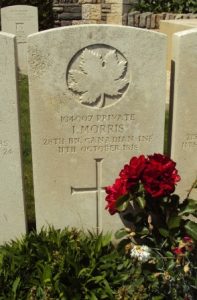
John Albert Morris, Private, 88646, The King’s (Liverpool Regiment). John was the son of Jane Morris (nee Turner, formerly Brown) of Oak Farm, Mochdre. His mother had been raised in Montgomery by her grandparents. John worked as a cattleman for Edward and Margaret Morris at Penthryn, Mochdre, prior to the war. He enlisted into the army at Newtown and was initially posted to the East Surrey Regiment. John was then transferred to the 2/7th Battalion, The King’s (Liverpool Regiment), which was attached to 171 Brigade, 57th (West Lancs) Division. The battalion embarked for France with the Division on 13 February 1917 and disembarked at Le Havre the following day, before moving to the Strazeele area. The Division then took over billets at Fleurbaix before moving into the front line in the Boutillerie sector, for trench initiation and training. The Division held various sectors in the area over the coming months and then in October 1917 moved north into the Ypres Salient, taking part in the Second Battle of Passchendaele. During the middle of November, the Division moved out to the Nordausques area to rest. In January 1918 the Division moved back to the Erquinghem sector and over the coming weeks again held various sectors of the front line in the area. As a result of heavy losses suffered by the Allies during the German Spring offensive, to the south, the Division left Flanders at the beginning of April and transferred to the Somme sector, near Gommecourt. From 21 August 1918 onwards, the Division took part in the great offensive, driving towards the Hindenburg Line. By 31 August John’s battalion was in position ready to assault the strongly defended village of Hendecourt and on the following day, 1 September 1918, launched its assault, capturing all of the objectives as planned. John was killed in action during the days fighting. The 22-year-old has no known grave and is commemorated on the Vis-en-Artois Memorial, France.
George Mountford. George cannot presently be positively identified. There were only a handful of men of that name who fell during the Great War, none of whom have any links with Montgomery. There were only two men of that name who lived in the town: George Mountford, born in 1871, and his son, George Edgar Mountford, born in 1900. George Edgar Mountford died in Canada in 1947, whilst his father died in 1934.
John Bernard Poultney, MiD, Second Lieutenant, South Lancashire Regiment. John was born in Ulverston, Lancashire on 7 June 1882, the son of Edward William Poultney and Josephine Susannah Poultney (nee Gibson). He trained as a Solicitor, and by 1911 was residing at Vincent Avenue Stratford-On-Avon. His father died in 1912, and his mother moved to Oakfield Cottage, Montgomery soon afterwards, with John’s sister, Susie. John then emigrated to America in 1912 aboard the White Star liner SS Olympic, and lived at Queens, New York. Following the outbreak of war, John returned to England, and enlisted into the Inns of Court Officers Training Corps. He was commissioned as Second Lieutenant on 2 July 1915 into the 4th Battalion, South Lancashire Regiment, and was posted to their 3rd Battalion for training. John then embarked for France in March 1916, joining the 8th Battalion, South Lancashire Regiment, which was attached to 75 Brigade, 25th Division. On 3 July 1916, two days after the opening of the Battle of the Somme, the Division advanced from positions at Aveluy Wood into trenches on the Tara-Usna Line and assaulted the German positions at Ovillers and La Boiselle. John was wounded during this assault, and spent several weeks in hospital before returning to duty with the battalion. In the meantime, the 25th Division had remained on the Somme until being transferred to the Ploegsteert sector at the end of October 1916, taking over the line east of Ploegsteert Wood. At the end of January 1917, the 8th South Lancs were in billets at Pont De Nieppe, and on the following day relieved the 2nd South Lancs in the Left Le Touquet Sector, to begin a short tour in the line. On 8 February the battalion was relieved, moving back to its billets, then on 15 February, moved back into the front line, to begin another routine tour. On 18 February 1917 the battalion carried out a trench raid on the German trenches south-east of Ploegsteert Wood, but suffered the loss of John and four other men killed, 35 wounded, and five men missing. John was 34-years-old when he was killed during the raid. He has no known grave and is commemorated on the Ploegsteert Memorial, Belgium. John had been mentioned in despatches during his time in France. His elder brother, Edward Cecil Poultney, had emigrated to New York in 1913, and had served with the American Expeditionary Force during the war.
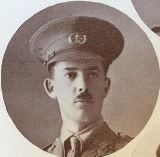
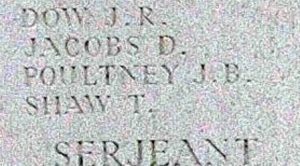
James Robertson, Second Lieutenant, Highland Light Infantry. James was born in 1898, the son of Doctor James John Robertson, of Oakfield, Montgomery. His mother died soon after his birth, and James was raised by his grandparents, Thomas and Jane Howells, at Shepherd’s Whim, Aston. James was educated at Montgomery before going to Murchison College, Edinburgh to complete his studies. His father died in 1911, and James was fostered by Mrs Margaret Ewen, of Edinburgh. James enlisted into the army in December 1916, and soon gained a commission as Second Lieutenant into the 4th Battalion, Highland Light Infantry. James embarked for France in January 1917, and was attached to the 19th Battalion, Durham Light Infantry, which was attached to 106 Brigade, 35th Division. James joined the battalion whilst it was in billets at Maisnil St. Pol, on 15 January, and was posted to X Company. The battalion remained here until 6 February, when it marched to billets in Bonnières, and two days later marched to Vignacourt, where the battalion remained until 19 February. By 26 February the 35th Division had taken over a section of the line in the Lihons Sector, and the 19th DLI was in support trenches. On 3 March the battalion moved into the front line, for James first experience of life in the trenches, and began a routine tour until being relieved on 6 March. The Germans began a well-planned withdrawal to the Hindenburg Line around this time, and the 35th Division was amongst those who followed the withdrawal, reaching positions east of Vadencourt by 10 April. The infantry battalions of the Division then began the usual routines of trench rotation over the coming weeks. On 2 June the 19th DLI was relieved after a routine spell in the front line at Villers-Guislain, and moved to the Divisional Reserve Camp at Aizecourt le Bas, where a training schedule was then carried out. James and Captain Noakes were injured whilst training on 6 June 1917, when a hand grenade prematurely exploded. James was taken to No 1 General Hospital at Etretat, but died of his wounds there on 9 July 1917. The 19-year-old was buried in Etretat Churchyard Extension, France.
Edward Lancelot Vaughan, Corporal, 290327, Royal Welsh Fusiliers. Edward was born at Worthen in 1896, the son of Thomas Edward Vaughan and Sarah Emily Vaughan (nee Trow). The family later resided at Brick Cottage, Montgomery. Edward worked as a Butcher prior to enlisting into the 7th Battalion, Royal Welsh Fusiliers at Montgomery on 10 September 1914. The battalion was a Territorial unit, which mobilised for war at Newtown in August 1914, as part of North Wales Brigade, Welsh Division and moved to Conway until the end of the month, before moving to Northampton. In December the Division moved to Cambridge and then in May 1915 to Bedford, where the Division was numbered and the formation became 158 Brigade, 53rd (Welsh) Division. On 19 July 1915 the entire Division sailed from Devonport for Imbros and on 9 August 1915 landed at Suvla Bay. The infantry moved off the beaches into the bush, but due to a lack of maps and no knowledge of the terrain, many of the units became disorientated, and the situation became chaotic. The Division was eventually evacuated from Gallipoli in December 1915, moving to Egypt to join the EEF, and helped guard the Suez Canal before taking part in operations to drive the Turks out of the Sinai. The EEF then turned its attention onto driving the Turks out of Palestine, and on 26 March 1917 launched its first offensive against the coastal city of Gaza, which guarded the road to Jerusalem. Initial gains during the day were lost when the assaulting divisions lost touch with each other and communication broke down when a thick fog cloaked the battlefield. A second attempt to force Gaza was launched on 17 April, which also failed, and the EEF suffered a change in leadership, with Sir Edmund Allenby assuming command, before being re-organised, and a third offensive was launched against a wider front from Beersheba to Gaza on 31 October 1917. This time the Turkish defences were breached, and the road to Jerusalem now lay open and the EEF began to advance north. On 6 November 1917, 158 Brigade launched an attack on the Khuweilfeh Heights. Edward was killed in action during the assault that day. The 21-year-old has no known grave and is commemorated on the Jerusalem Memorial, Israel. He is also commemorated on the Worthen war memorial.
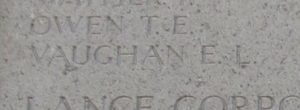
Edward William Whittingham, Private, 25360, South Wales Borderers. Edward was the son of Edward Whittingham and Margaret Whittingham, of Mill House, Montgomery. He enlisted into the King’s Shropshire Light Infantry at Wrexham, and after completing his training was drafted to France in the summer of 1917. Edward was then among a number of KSLI men transferred to the 10th and 11th Battalions, of the South Wales Borderers in June 1917, both of which were at Ypres, attached to 115 Brigade, 38th (Welsh) Division. Edward initially joined the 11th Battalion, South Wales Borderers, which had moved with the Division to Ypres the previous year, following its famous assault on Mametz Wood in July 1916. The Division then took over the Canal Bank sector at Boesinghe. The infantry battalions of the Division then began carrying out the normal pattern of rotation in the trenches, four days in the front, four in support and four in reserve, whilst also working on trench improvement, digging new trenches, and also carrying out regular patrols and trench raids. On 31 July 1917 the Division launched its famous assault on the Pilckem Ridge, capturing Iron Cross and reaching its objective of the Steenbeek, then played a supporting role in the Battle of Langemarck. The Division was transferred to the Sailly-sur-la-Lys sector in September, and remained in the area over the winter. In February 1918 the British army was re-organised, due to a serious shortage of manpower, and the 11th SWB was disbanded, with the 2nd Battalion, Royal Welsh Fusiliers taking its place in 115 Brigade. Edward then transferred to the 10th Battalion, South Wales Borderers, in the same 115 Brigade. The Germans launched the first phase of their Spring offensive to the south on 21 March 1918, and drove the Allies back over a series of terrible days, so the 38th (Welsh) Division was moved to positions north of Albert, at Bouzincourt Ridge, at the end of March 1918, relieving the battered 2nd and 47th Divisions. Edward was killed in action whilst the 10th SWB was holding the Mesnil Sector Support Line on 5 June 1918. The 20-year-old was buried in Engelbelmer Communal Cemetery Extension, France.
Raymond Nathan Wilcox, Private, 291518, Royal Welsh Fusiliers. Raymond was the son of Nathan and Mary Wilcox, of Yewtree Cottage, Chirbury. He was residing at Church Bank, Montgomery, and was working as a Baker, when he enlisted at Welshpool into the army, and was posted to Wrexham, where he was attested into the 7th Battalion, Royal Welsh Fusiliers on 23 March 1916. Raymond was posted to the 3/7th Battalion, Royal Welsh Fusiliers, at Park Hall Camp, Oswestry for training, before embarking at Devonport for Egypt on 6 September 1916. Upon disembarking at Alexandria on 17 September, Raymond joined the Infantry Base Depot before being posted to the 1/7th Battalion, Royal Welsh Fusiliers, which was attached to 158 Brigade, 53rd (Welsh) Division. The Division had been evacuated from Gallipoli in December 1915, moving to Egypt to join the EEF, and helped guard the Suez Canal before taking part in operations to drive the Turks out of the Sinai. The EEF then turned its attention onto driving the Turks out of Palestine, and on 26 March 1917 launched its first offensive against the coastal city of Gaza, which guarded the road to Jerusalem. Initial gains during the day were lost when the assaulting divisions lost touch with each other and communication broke down when a thick fog cloaked the battlefield. Raymond was killed in action during the terrible fighting that day. The 20-year-old is buried in Gaza War Cemetery.
William Henry Williams, Sergeant, 11163, Cheshire Regiment. William was born at Cwm Dingle, Priest Weston, Shropshire in 1892, the son of William Williams and Martha Williams. The family later moved to Burnt House, Chirbury Road, Montgomery. William moved to Yorkshire to find work as a collier prior to the war, but when war erupted was residing at Crewe, where he enlisted into the 8th Battalion, Cheshire Regiment. The battalion was formed at Chester in August 1914, moving to Tidworth to join 40 Brigade, 13th (Western) Division. The Division moved to Chiseldon in October 1914, then in February 1915 moved to Pirbright, Aldershot. On 13 June 1915 the Division embarked for Egypt, before landing at Cape Helles, Gallipoli from 6 July 1915, relieving the 29th Division. The Division then left and returned to Mudros at the end of the month, and the entire Division landed at ANZAC Cove between 3 and 5 August 1915, taking part in the heavy fighting which followed, during the Battles of Sari Bair, Russell’s Top, and Hill 60, ANZAC. The Division was later transferred from ANZAC to Suvla Bay, and it was evacuated from Suvla on 19 December 1915, moving after a week’s rest to the Helles bridgehead, where the Division faced the last Turkish attacks at Helles. On 8 January 1916, the Division was evacuated from Helles, and by 31 January was concentrated at Port Said, where it held forward posts in the Suez Canal defences. On 12 February 1916 the Division began to move to Mesopotamia, to strengthen the force being assembled for the relief of the besieged garrison at Kut al Amara. By 27 March, the Division had assembled near Sheikh Saad and came under orders of the Tigris Corps, and then took part in the attempts to relieve Kut. However, after these efforts failed and Kut fell, the British force in the theatre was built up and reorganised. The Division then fought at the Battle of Kut al Amara, then at the capture of the Hai Salient and the capture of Dahra Bend. It took part in the passage of the Diyala, in the pursuit of the enemy towards Baghdad, and part of the Division were the first British troops to enter Baghdad. During the rest of March and April 1917, operations were undertaken to consolidate the position won at Baghdad, by pushing north across Iraq. William was sent home at some time after contracting malaria, and after recovering was posted to the 2nd Battalion, Cheshire Regiment. His health must have deteriorated, as William was posted home, joining the Depot Battalion of the Cheshire Regiment at Kinmel Park. He died at the Malaria Concentration Centre at Kinmel Park on 17 October 1918. The remains of the 26-year-old were brought home and he was buried with full military honours in St. Nicholas Churchyard, Montgomery.
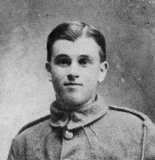
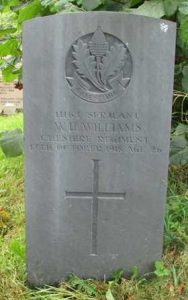
World War Two, 1939-1945
John James Ancham, Corporal, 4193876, Hampshire Regiment. John was born in 1920, the son of James Lewis Ancham and Edith Emily Ancham (nee Edwards), of Montgomery. He enlisted into the army following the outbreak of war, and whilst based in Northern Ireland, married Violet, of Newtownards, Co. Down. John was then transferred to the 1st Battalion, Hampshire Regiment. The battalion had been in Egypt at the outbreak of war, taking part in the Western Desert and the North African Campaigns, before taking part in Operation Husky, the invasion of Sicily, where it suffered heavy casualties when it came up against the Herman Goring Parachute Panzer Division. The battalion, as part of the 231st Infantry Brigade, then landed in Italy, but in November 1943 was brought back to England to prepare for D-Day. John probably joined the battalion around this time. The battalion was then attached to the 50th (Northumbrian) Infantry Division, one of the chosen assault divisions for the Normandy Landings, and landed on 6 June 1944, capturing Le Hamel and Arromanches. The battalion then took part in the fighting for the village of Hottot, against the German Panzer-Lehr-Division, and after a brief rest took part in the assault towards Villiers Bocage. By the end of August, the battalion had crossed the River Seine, and took part in the drive northwards through France into Belgium and Holland, coming under command of the Guards Armoured Division, and took part in Operation Market Garden. The battalion then saw heavy fighting in ‘The Island, the bridgehead over the river Waal but behind the river Lek. The battalion was withdrawn and moved to Ypres at the end of November, and John was among a number of men of the battalion posted to replace losses in other units. He died in Germany on 13 April 1945, aged 24. He was originally buried in Kloppenburg, Germany, but on 17 September 1946 his grave, together with all of the other Commonwealth burials in the cemetery, were re-interred in Becklingen War Cemetery, Germany.
Cyril Berwick, Private, 4467050, Durham Light Infantry. Cyril was born on 19 March 1910, the son of John Berwick and Catherine Berwick (nee Jones), of 2 Thornloe Cottage, Montgomery. Prior to the outbreak of war, Cyril and his younger brother Francis were lodging at 12, Grove Avenue, Solihull, where they had both found work, Cyril as an assistant butcher, and Francis as a labourer. Cyril enlisted into the army soon after the outbreak of war and was posted to the 16th Battalion, Durham Light Infantry. The battalion was raised in Edinburgh following the outbreak of war, before moving to Norfolk, where its ranks were filled with new recruits. Cyril died at Norwich Hospital in Norfolk on 17 June 1941. The remains of the 31-year-old were brought back home, and he was buried in St. Nicholas Churchyard, Montgomery on 21 June.
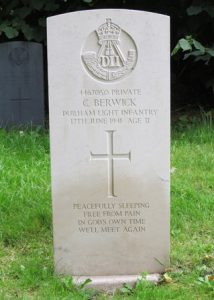
Francis Knightley Butler, Leading Aircraftman, 346920, Royal Air Force Volunteer Reserve. Francis was born in Birmingham in 1903, the son of Francis and Minnie Butler. He married Bertha May Williams at Montgomery in 1926 and the couple set up home at Clive House, Montgomery. Francis enlisted into the Royal Air Force Volunteer Reserve soon after the outbreak of war, and served at home for most of the war. Francis contracted tuberculosis during his time at war, and died at the RAF Hospital at Evesham on 26 December 1944. The remains of the 41-year-old were brought home for burial in St. Nicholas Churchyard, Montgomery. His widow, Bertha, died four months later, on 21 April 1945, and was buried with him.
Adam Brownlee Hogg, Petty Officer Stoker, D/KX 89142, Royal Navy. Adam was born at Melrose, Scotland on 28 May 1913, the son of Harry Crichton Hogg and Helen Hogg. He enlisted into the Royal Navy as a young man, and married Phyllis Cleverly, a waitress from Plymouth, whilst based there in 1940. He had served aboard the battlecruiser HMS Glorious and the destroyer HMS Tartar before being posted aboard the armed yacht, HMS White Bear, which had been requisitioned by the Royal Navy in 1939 and converted for use as a submarine tender, initially under the command of Roy Gill. On 12 December 1942, Commander James Francis Drake, RN took over command of White Bear. On the following day, White Bear was operating at Greenock, Scotland, when her boiler exploded, killing one man, Stoker William Hatton, and mortally injuring Adam and two other sailors, John Nutt and Frederick Scantlebury. All three men died of their injuries later that day. Adam was 29-years-old when he died that day and was buried alongside his fellow crewmen in Greenock Cemetery, Scotland. His widow, Phyllis, had been evacuated to Montgomery from Plymouth soon after their marriage, but after the war lived in Canton, Cardiff.
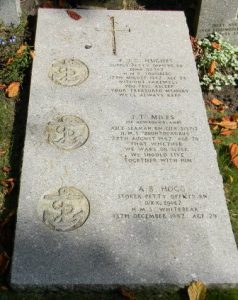
John Alfred Morgan, Able Seaman, P/JX 126115, Royal Navy. John was born at Birmingham on 23 July 1910, the son of Alfred Morgan and Mabel Emma Morgan (nee Taylor). His father Alfred was originally from Kerry, but had worked in Birmingham for several years prior to moving the family to Montgomery soon after John’s birth. John worked as a gardener prior to enlisting into the Royal Navy on 4 February 1926, and his first posting was posted to the shore establishment HMS Impregnable for training, aboard the old battleship HMS Powerful at Devonport. John then then posted aboard the old WW1-era battleship, HMS Iron Duke, which was being used as a gunnery training ship, at Devonport, then on 27 August 1937 John was posted aboard the old super-dreadnaught battleship, HMS Revenge, which served with the Home Fleet. John then had a short posting aboard the battleship HMS Nelson, before being transferred to the destroyer HMS Exmouth. John married Margaret Hilda Thomas, of Newtown, whilst home on leave in 1939, but soon returned to HMS Exmouth. She was at the time being utilised for training duties and local flotilla work based at Portsmouth until 2 August 1939, when she was placed into full commission as the leader of the 12th Destroyer Flotilla. She escorted HMS Hood as she searched for German commerce raiders south of Iceland in late November 1939, before being transferring to the Western Approaches Command and moved to Rosyth. Exmouth was in the Moray Firth, escorting the merchant steamer Cyprian Prince on 21 January 1940 when she was spotted by the German submarine U-22, and was torpedoed, sinking with the loss of all hands. John was 29-years-old when he was drowned in the sinking, and is commemorated on the Portsmouth Naval Memorial, Hampshire.
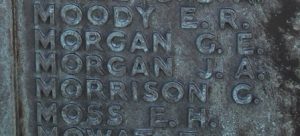
George Harold Pennie, Leading Aircraftman, 1414922, Royal Air Force Volunteer Reserve. George was born on 2 May 1912, the son of Edward Pennie and Mary Pennie (nee Pritchard), of Rock Cottage, Montgomery. He worked as a Grocer’s Roundsman prior to enlisting into the Royal Air Force Volunteer Reserve soon after the outbreak of war. George served throughout the entire war, and was on sick leave from RAF Cosford when he was found dead between Forden and Montgomery on 1 May 1945. The 33-year-old was buried in St. Nicholas Churchyard, Montgomery on 4 May 1945.
Charles Ronald Clive Perry, Sergeant, 1165304, Royal Air Force Volunteer Reserve. Charles was the son of Charles and Selina Millicent Perry, of Montgomery. He married Alice Done, of Clive, in 1939, and the couple lived in the Crown Hotel, Montgomery, where Charles was a Licensed Victualler and Coal Merchant’s Clerk. Charles enlisted into the Royal Air Force Volunteer Reserve, and trained as a Wireless Operator prior to being posted to 50 Squadron, RAF. The Squadron had reformed at RAF Waddington on 3 May 1937, equipped with Hawker Hind biplanes, then converted to the Handley Page Hampden medium bomber in December 1938, joining 5 Group, Bomber Command. The Squadron began operations on 19 March 1940 against occupied Europe, but after a day of heavy losses on 12 April 1940, stopped daylight operations and began operations at night. On the night of 25 March 1942, Charles took off from RAF Skellingthorpe aboard a Handley Page Hampden I, Serial AT158, which had been sent as part of a force from the Squadron to lay mines in the Artichokes area outside the important German submarine base in the French coastal town of Lorient. The aircraft crashed in the target area that night, killing all four of her crew. Charles was 32-years-old when he was killed during the operation, and is buried in Kerentrech Communal Cemetery in the northern outskirts of Lorient.
Douglas John Purcell, Flight Sergeant, 1179990, Royal Air Force Volunteer Reserve. Douglas was born at Chipping Sodbury in 1921, the son of George Purcell and Gwladys Jane Purcell (nee Reece, formerly Gulwell). His mother had lost her first husband, William Gulwell, when he died of wounds during the Battle of the Somme in 1916, and had married George Purcell in 1918. The couple then bought the Lion Hotel, Montgomery, and Douglas was raised there. Douglas enlisted into the Royal Air Force Volunteer Reserve, and trained as a Flight Engineer before being posted to 78 Squadron, RAF. The Squadron had reformed at RAF Boscombe Down on 1 November 1936, equipped with the Handley Page Heyford, then moved to RAF Dishforth in Yorkshire early in 1937, joining No. 4 Group, of RAF Bomber Command, and later that year converted to Armstrong Whitworth Whitley bombers. The Squadron moved to RAF Linton-on-Ouse on 15 October 1939, but returned to Dishforth in July to begin work as a night bomber squadron. In April 1941, the squadron moved to RAF Middleton St. George, and in September flew its first bombing raid against Berlin. It moved again, to RAF Croft, in October 1941, and continued operations over occupied Europe, re-equipping with Handley Page Halifax’s early in 1942. On 27 August 1943, Douglas took off from RAF Breighton aboard a brand-new Handley Page Halifax B.II, Serial LW235, which formed part of a force despatched to bomb strategic targets in Nuremberg. Douglas was killed, along with all but one of his fellow crewmen, when their Halifax exploded due to a fuel tank fire whilst over the target that night. The 22-year-old was originally buried with his fellow crewmen in South Nurnberg Cemetery, but on 9 September 1947 their graves, together with all of the other Commonwealth burials in the cemetery, was re-interred in Durnbach War Cemetery, Germany.
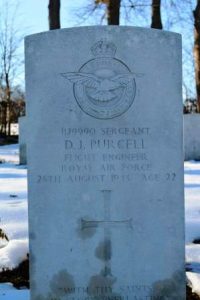
Kenneth Wynne Rogers, Sub-Lieutenant, 1062, Royal Naval Volunteer Reserve. Kenneth was born at Montgomery on 26 August 1923, the son of Harold Thompson Rogers and Sarah Pugh Towena Rogers (nee Jones), of Castle View. He enlisted into the Royal Naval Volunteer Reserve following the outbreak of war, and was posted aboard HM Landing Craft Gun (Large) 1062. The Landing Craft took part in Operation Overlord, ferrying troops to the Normandy landing beaches from 6 June 1944 onwards. On 31 July 1944, HMLCG (L) 1062 struck a mine and sank whilst returning from Normandy, going down with the loss of at least six men. The body of 20-year-old Kenneth, together with two others from the Landing Craft, were later recovered from the sea, and buried in Hollybrook Cemetery, Southampton.
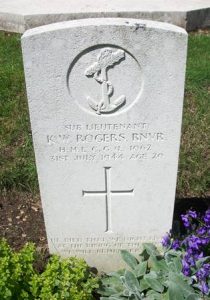
Arthur Norman Waldron, Fusilier, 4194294, Royal Welch Fusiliers. Arthur was born in Bromsgrove in 1916, the son of Francis Walter Waldron and Emmie Isabella Waldron (nee Horne). He married Doris Berwick, the daughter of John and Catherine Berwick, of Chirbury Road, Llandinam, in 1939. Arthur enlisted into the 7th Battalion, Royal Welch Fusiliers, which was attached to 158 Brigade, 53rd (Welsh) Division. The battalion was mobilised at the outbreak of war, when the Division moved to Northern Ireland to begin garrison duties. The Division then moved to Pembroke Dock, before moving again to the south of England, where it trained in readiness for the D-Day Landings. On 24 June 1944 the 7th RWF left England for Normandy, and landed at La Riviere near Ver Sur Mer. The Division then took part in heavy fighting over the coming weeks, as part of the effort to break-out of the Normandy beach-head, seeing heavy fighting at Évrecy, before starting the epic advance through Northern France into Belgium and Holland. On 15 September the Division forced the crossing of the Junction Canal North of Lommel, and continued to push westwards towards Elst, between Nijmegen and Arnhem, during Operation Market Garden. On 22 October the Division launched its famous assault on ‘s-Hertogenbosch, before continuing its advance to the German frontier. Between December 1944 and January 1945, the Division took part in the Battle of the Bulge, helping in the counter-attack which helped save the Americans, who were under heavy pressure, then after the German offensive was broken, took part in heavy fighting to enter the Rhineland. Arthur was killed during the fighting for the Reichswald Forest on 13 February 1945. The 29-year-old is buried in Rheinberg War Cemetery, Germany.
